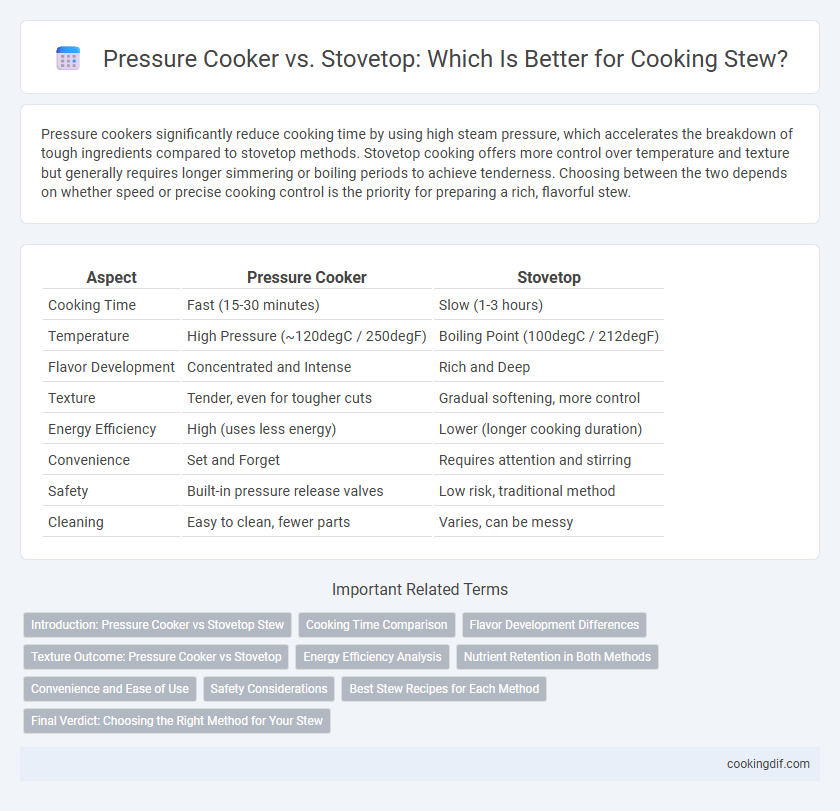Pressure cookers significantly reduce cooking time by using high steam pressure, which accelerates the breakdown of tough ingredients compared to stovetop methods. Stovetop cooking offers more control over temperature and texture but generally requires longer simmering or boiling periods to achieve tenderness. Choosing between the two depends on whether speed or precise cooking control is the priority for preparing a rich, flavorful stew.
Table of Comparison
| Aspect | Pressure Cooker | Stovetop |
|---|---|---|
| Cooking Time | Fast (15-30 minutes) | Slow (1-3 hours) |
| Temperature | High Pressure (~120degC / 250degF) | Boiling Point (100degC / 212degF) |
| Flavor Development | Concentrated and Intense | Rich and Deep |
| Texture | Tender, even for tougher cuts | Gradual softening, more control |
| Energy Efficiency | High (uses less energy) | Lower (longer cooking duration) |
| Convenience | Set and Forget | Requires attention and stirring |
| Safety | Built-in pressure release valves | Low risk, traditional method |
| Cleaning | Easy to clean, fewer parts | Varies, can be messy |
Introduction: Pressure Cooker vs Stovetop Stew
Pressure cookers significantly reduce cooking time for stews by using high-pressure steam, infusing flavors quickly and tenderizing meat efficiently. Stovetop methods provide slower, controlled heat, allowing gradual flavor development and texture improvement over time. Choosing between them depends on the desired balance between convenience and depth of taste in stew preparation.
Cooking Time Comparison
Pressure cookers significantly reduce stew cooking time by using high-pressure steam to rapidly tenderize meat and vegetables, often finishing in 30-45 minutes compared to 2-3 hours on a stovetop. Stovetop simmering allows for gradual flavor development but requires constant monitoring and longer heat exposure. The pressure cooker's sealed environment maintains moisture and nutrients, making it the most efficient method for quick stew preparation.
Flavor Development Differences
Pressure cookers enhance stew flavor by sealing in steam and intensifying ingredient aromas through rapid high-pressure cooking, resulting in deeper, more concentrated taste profiles. Stovetop cooking allows for gradual simmering, promoting complex Maillard reactions and gradual flavor layering that develop subtle, nuanced stews. The choice between pressure cooker and stovetop directly impacts stew complexity, with pressure cooking emphasizing richness and stovetop methods fostering intricate flavor depth.
Texture Outcome: Pressure Cooker vs Stovetop
Pressure cookers rapidly tenderize stew ingredients by trapping steam under high pressure, resulting in consistently soft textures and well-infused flavors within a shorter cooking time. Stovetop methods offer more control over simmering, allowing gradual breakdown of tougher cuts but may require longer cooking periods to achieve similar tenderness. The pressure cooker's sealed environment preserves moisture effectively, whereas stovetop cooking can lead to varied textures depending on heat regulation and liquid evaporation.
Energy Efficiency Analysis
Pressure cookers reduce cooking time significantly by trapping steam and increasing internal pressure, which leads to faster heat transfer and lower energy consumption compared to stovetop methods. Stovetop cooking often requires longer heating periods and continuous fuel use, resulting in higher energy expenditure and heat loss. The energy efficiency of pressure cookers can be up to 70% greater than traditional stovetop cooking for stews, making them a sustainable choice.
Nutrient Retention in Both Methods
Pressure cookers preserve more nutrients in stew by reducing cooking time and exposure to heat, which limits nutrient degradation. Stovetop cooking, while effective for flavor development, often results in greater nutrient loss due to longer cooking periods at higher temperatures. Studies show pressure-cooked stews retain higher levels of vitamin C and B-complex vitamins compared to traditional stovetop methods.
Convenience and Ease of Use
Pressure cookers enhance convenience by significantly reducing stew cooking time through high-pressure steam, allowing for quick meal preparation and energy efficiency. Stovetop cooking offers straightforward usability with simple controls and immediate access to adjust heat but generally requires longer cooking periods and more active monitoring. For ease of use, electric pressure cookers provide automated settings and timers, while stovetop models rely on the cook's attention and experience to achieve optimal results.
Safety Considerations
Pressure cookers offer enhanced safety features such as locking lids and pressure release valves that prevent accidental opening under high pressure. Stovetop cooking requires constant monitoring to avoid boil-overs or burns, while electric pressure cookers automate pressure control and reduce the risk of overheating. Proper maintenance of seals and safety mechanisms in pressure cookers is essential to ensure secure operation during the stew cooking process.
Best Stew Recipes for Each Method
Pressure cookers reduce cooking time significantly by using high pressure to tenderize meat quickly, making them ideal for hearty beef or lamb stews with rich, deep flavors. Stovetop cooking offers more control over simmering temperature, perfect for delicate vegetable stews or traditional chicken stews where slow cooking enhances texture and melds flavors. Recipes like classic beef bourguignon excel in pressure cookers, while rustic Italian vegetable or chicken cacciatore stews benefit from the gradual cooking process on the stovetop.
Final Verdict: Choosing the Right Method for Your Stew
Pressure cookers significantly reduce cooking time by using high-pressure steam to tenderize meat and infuse flavors rapidly, making them ideal for busy households. Stovetop simmering offers greater control over texture and gradual flavor development, resulting in a traditional, richly layered stew. Selecting the right method depends on whether speed or depth of flavor is prioritized, with pressure cookers excelling in convenience and stovetop methods providing nuanced taste complexity.
Pressure cooker vs stovetop for cooking process Infographic

 cookingdif.com
cookingdif.com